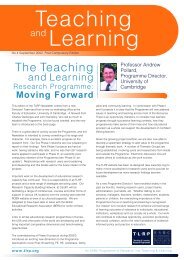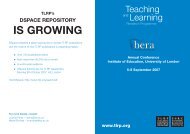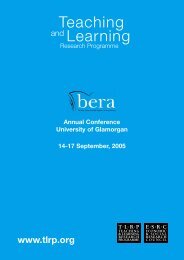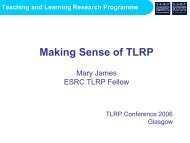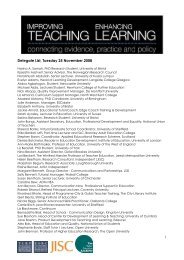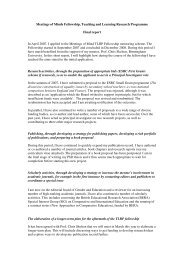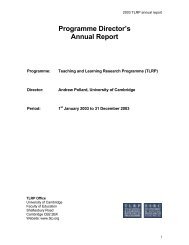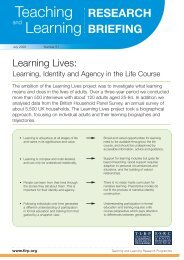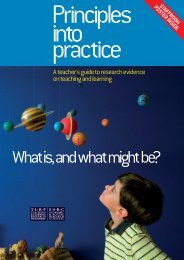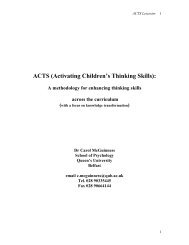Education 2.0? - Teaching and Learning Research Programme
Education 2.0? - Teaching and Learning Research Programme
Education 2.0? - Teaching and Learning Research Programme
- No tags were found...
Create successful ePaper yourself
Turn your PDF publications into a flip-book with our unique Google optimized e-Paper software.
Virtual worlds <strong>and</strong> learning - key messages from the researchEducators are showing fervent interest in virtual worlds. Reports <strong>and</strong> papers are becoming available, butin-depth, peer-reviewed studies of learning <strong>and</strong> pedagogy in virtual worlds are still rare. The sheer range ofdisciplinary perspectives (from the computer sciences to the visual arts) <strong>and</strong> variety of teaching <strong>and</strong> learningcontexts (from adults to children, from formal to informal) make it difficult to draw general conclusions or toencapsulate findings.Reports <strong>and</strong> papers are becoming available, but in-depth, peer-reviewed studies of learning <strong>and</strong> pedagogyin virtual worlds are still rare. The sheer range of disciplinary perspectives (from the computer sciences to thevisual arts) <strong>and</strong> variety of teaching <strong>and</strong> learning contexts (from adults to children, from formal to informal) makeit difficult to draw general conclusions or to encapsulate findings.For educators, the existing literature on pedagogy <strong>and</strong> social learning, playful learning, drama, simulations,practical experimentation <strong>and</strong> communities of practice has clear relevance to virtual worlds. Virtual worlds alsopresent educators with an opportunity to revisit questions of ‘presence’ or ‘immersion’ <strong>and</strong> thus make referenceto older ‘virtual reality’ studies. <strong>Research</strong>ers appreciate that existing literature might be relevant, yet alsorecognise that these concepts <strong>and</strong> theories might themselves be challenged or altered when applied to virtualworlds. It is already possible to point to gaps in the literature <strong>and</strong> suggest areas for future research. Theseinclude:• pedagogy <strong>and</strong> curricular design;• social learning;• the emergence of viable alternatives to Second Life;• equality <strong>and</strong> access (in relation to disability or broadb<strong>and</strong>, for example;• institutional policyFurther work on theories of immersion, presence, identification, agency, role <strong>and</strong> affect could also enrichresearch in this area.When researching or seeking to use virtual worlds as educational tools, it is important to acknowledge theirambiguity <strong>and</strong> variability. But this ambiguity is not a problem to be designed out. It allows virtual worldsto ‘render strange’ the conventions that underlie teaching including teacher <strong>and</strong> student roles, classroomlayout <strong>and</strong> assessment practices. Virtual worlds have the potential to trouble the roles of teacher, learner <strong>and</strong>researcher in productive ways. These offers - in addition to their more obvious social, technical <strong>and</strong> creativepotentials - are why educators are right to be interested in virtual worlds.



